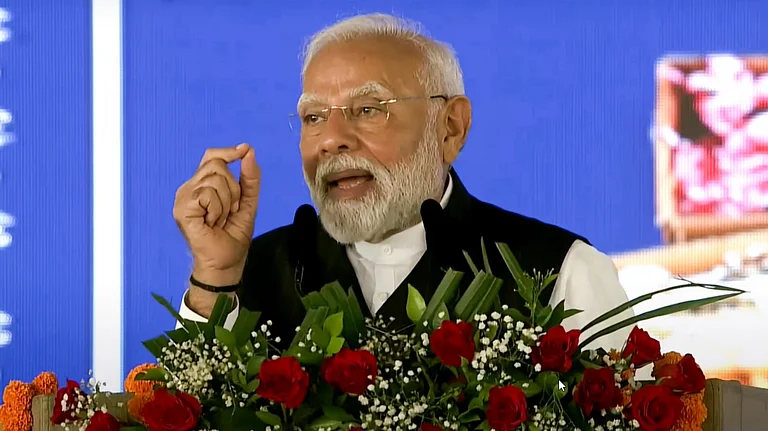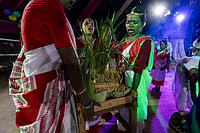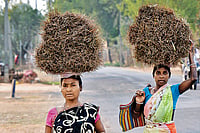The celebration of Dharti Aba Shaheed Birsa Munda’s birth anniversary as Tribal Pride Day every year may have found favour among the different tribes of the country, but the descendants of Birsa are not pleased with the nomenclature. Kanhu Munda, 32, asks why the day should not be celebrated as Birsa Munda Day instead.
Kanhu is the son of Sukhram Munda and the great-great-grandson of Birsa Munda. He expresses his displeasure with the Prime Minister over other things besides. “Prime Minister Narendra Modi came to our village. That was a big gesture. We were told that he would talk to our Baba [Sukhram Munda] and the villagers and get to know our problems. Even the DC said that he would talk to us for two minutes. But the Prime Minister did not talk to us even for a second. It seemed as though he was there just to get his picture clicked on Birsa Jayanti,” he tells Outlook.
In 2021, the Government of India announced that Birsa Jayanti, that is 15th November, would be observed as Tribal Pride Day. A year later, on the same day in 2022, President Draupadi Murmu visited Birsa's village Ulihatu (in the Khunti district of Jharkhand), and so did Prime Minister Modi another year later. From the land of Birsa, he announced schemes for tribals worth Rs 24 thousand crores.
It was for the first time in the 75 years since Independence that the Prime Minister and the President visited Birsa’s village. Birsa's descendants, however, were left more sad than happy on the occasion, because neither of the esteemed visitors spoke with Birsa's family or with the villagers. Says Kanhu Munda, “Prime Minister Narendra Modi is called a development man, but for our village, he is a showman who has spent crores of rupees in the name of our ancestor just so that he could get his picture clicked here.”
However, whatever may be Modi’s image in Birsa’s village and in the eyes of his descendants, Modi has consolidated his presence in various forms among a large population of the tribals.
In the villages of Kendujhar in Jharkhand's neighbouring state of Odisha, Modi is known as a “development man”. In the Upargajar village of the Banspal block, comprising some 600 homes many of which are tribal, development picked up steam only after Modi became Prime Minister. Kugeshwar Purti, 35, cannot recall any slogan of the Biju Janata Dal government, but he recites all of Modi’s slogans in a single breath: “Har Har Modi, Ghar Ghar Modi”, “Modi hai to mumkin hai”, “Sabka Saath, Sabka Vikas”, and “Modi ki Guarantee''. He tells Outlook, “Our village got electricity only after Modi came to power. A road has been built. Every family has got housing under the Pradhan Mantri Awas Yojana. We have also received the gas scheme. We get money under the PM Kisan Yojana. In our village, only ten per cent of the total work remains to be done.”
Purti gives no credit to the state's Biju Janata Dal government for any of these developmental and welfare works. The state government, he believes, has not done as much as it should have in the tribal areas, whereas the Modi government has done a lot.
Modi’s presence among the tribals of Upargajar is remarkable. They believe that he has put a stop to bomb explosions in the country, eliminated fear from people’s hearts, brought back black money, and turned the country into a digital India. Purti says that though they live inside forests, they receive all this information through their mobile phones.
Over the past decade, Modi's image has evolved from the Gujarat model of development to that of a strong religious leader, with the latter finding acceptance among a large section of the tribals. Of the five states that went to the polls recently, three large tribal states yielded full majority to the BJP. This was a mandate not so much in favour of the party as it was of Modi. In Rajasthan and Chhattisgarh, the BJP ousted the Congress from power largely on the strength of Modi's brand. In Madhya Pradesh, not only did the party manage to beat 20 years of anti-incumbency, it actually grew in terms of seats. Remember that in these states, the Congress contested the elections projecting the faces of the respective CMs, while the BJP put Modi front and centre. The BJP won 53 of the 101 seats reserved for the Scheduled Tribes in these states.
Analysing the election data, senior journalist Faisal Anurag says, “Religion is an addiction and the tribals are hooked on it too. In these ten years, they have moved towards Hindutva more than ever before. The same is true of the Dalits and the backward people. The media has played a major role in erecting Modi's image among the tribals in the villages. It can be said that the media has brainwashed them. Today, if Modi has a religious image among the tribals, then the credit for it also goes to the media."
Anurag believes that Modi's image among the tribals is not of a development man, but as a prominent face of Hindutva, and that the Sangh machinery has played a pivotal part in the dissemination of this image to every household. He considers the tribals’ support of Modi in the elections of the three states to be the result of this image.
In Chhattisgarh and Madhya Pradesh, the BJP won 41 of the 76 seats reserved for the Scheduled Tribes, whereas in 2018, this figure was only 19. In the 2018 Chhattisgarh assembly elections, the Congress had won all of the 11 tribal reserved seats in the Bastar region, but the BJP managed to wrest seven of them this time, one of which is the Chitrakot assembly. Mura Ram, 48, resident of the Erpund village in Chitrakot, believes that talking about temples and Hindus is a matter of Modi's personal faith, but for the people of his village, Modi is a leader who keeps his promises. Praising Modi, Ram says, “The Prime Minister is doing a good job and that he takes all the sections along with him. He fulfils the guarantees he gives. We like him a lot in our village because all of us have got houses under the PM residence scheme. A road has been built. We also have cellular connectivity now. Modi and the country are being recognised all over the world.”
Commenting on the deforestation taking place in the Surguja Hasdeo Aranya in Chhattisgarh right under the Modi government’s purview, Ram says that the protesters have to see whether the trees being cut are alive or dead. Ram is also among the tribals who receive information about Modi on mobiles and WhatsApp.
Sharad Singh Kumre, 52, is a resident of the Jawarkathi village, Barghat block, Seoni district of Madhya Pradesh. He expresses worry over the things being served to the tribals on their mobile phones. He says that most of the tribals in his village are steeped in 'Modimania'. He sees it as a matter of concern because what the tribals see on their phones does not educate them about the state of education, employment, and environment; instead, there is constant hate-filled talk against a certain community.
Kumre says further, “In India, people are divided on the basis of religion and caste. Even though we are tribal, I was born in the Hindu religion. This religion teaches us to live together in harmony. In 2014, I was also taken in by Modi and his developmental image of Gujarat. But from 2014 to 2024, Modi has completely moved away from development to religion. In our village, people like Modi for temples and Hinduism. What’s more, they like him because he is putting down the Muslims. The rhetoric they are fed through their phones is filled with hate.”
According to Kumre, a large section of tribals in Madhya Pradesh are inclined towards Hindutva. That is why Modi enjoys a strong religious image among them.
Data shows that in the last ten years, Modi's image has strengthened significantly among the tribals of the Fifth- and Sixth-Schedule states. According to the 2011 census, 8.6 per cent of the total population of the country is tribal, that is, a population of ten crores belonging to 705 tribes. A majority of this population lives in the large Fifth-Schedule states of Jharkhand, Odisha, Madhya Pradesh, Rajasthan, Chhattisgarh, Gujarat, Maharashtra, and Andhra Pradesh, and in the Sixth-Schedule state of Assam in the North East. Barring Odisha and Andhra Pradesh, all these states are ruled by the BJP. In some of these states, the BJP came to power solely on the strength of 'Brand Modi'. To add to this, the BJP holds 31 of the 47 seats reserved for the Scheduled Tribes in the Lok Sabha as well. This is a historic feat for the party in its evolution from the Jana Sangh to the BJP.
(Translated by Kaushika Draavid)



























